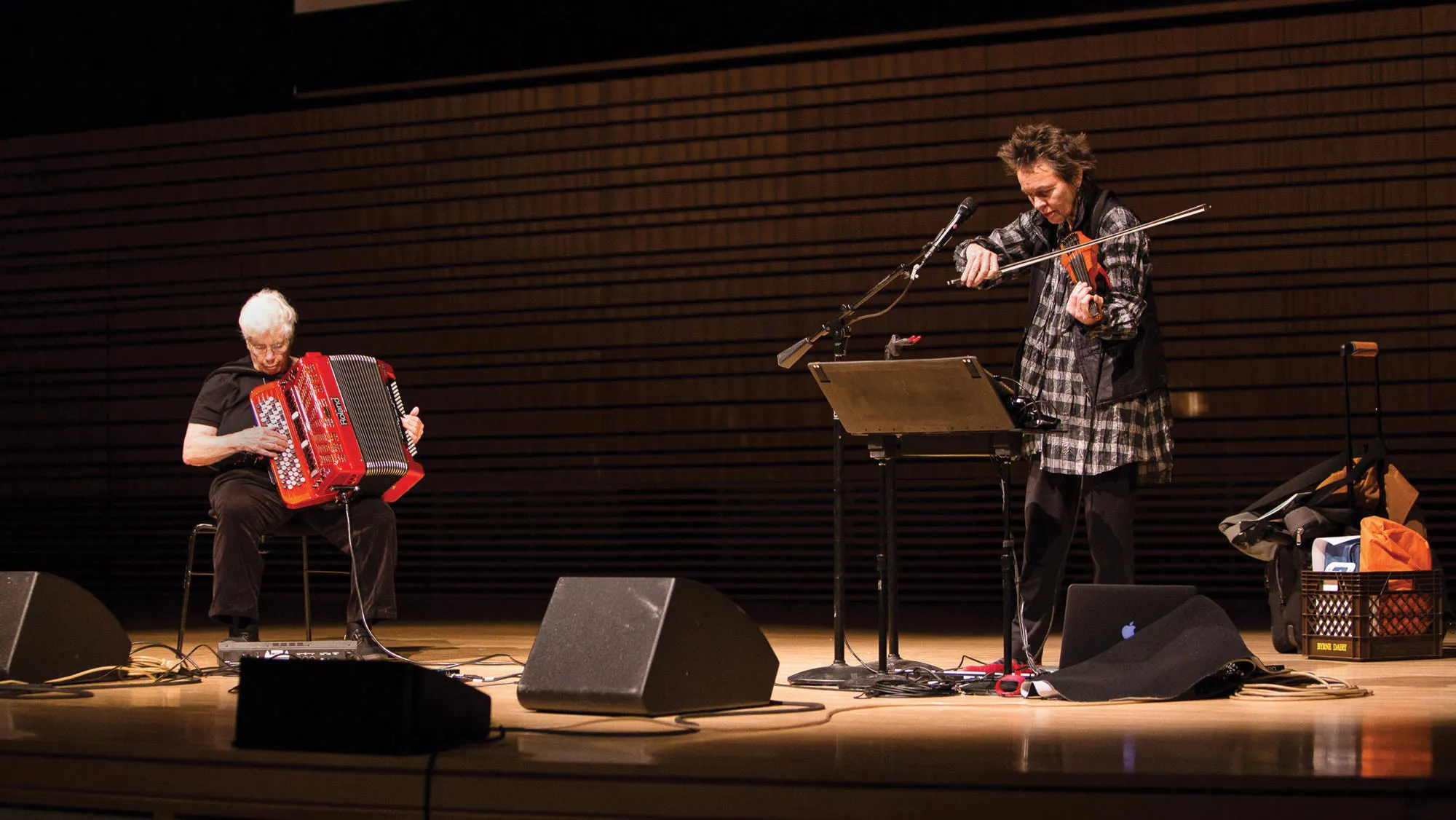In two back-to-back screenings in one evening, Laurie Anderson presented many of her films and videos, culminating in a silent film with live music performed by Anderson and Pauline Oliveros.
Laurie Anderson, EMPAC’s inaugural distinguished artist-in-residence, presented a series of events focusing on topics unique to her practice as an artist.
5PM PROGRAM
What You Mean We? (1987) What You Mean We? stars Laurie Anderson, who also wrote and directed the piece. It was originally produced as a segment of the PBS arts series Alive from Off Center.
Personal Service Announcements (early 1990s)
Carmen (1991) Anderson’s Carmen, who works in a tobacco factory, is as strong-willed and carefree as the original (she steals cigarettes off the assembly line). The one significant difference in that she is married. The young soldier from Georges Bizet’s original opera (1875) has been transformed into her indifferent husband who sits home idly watching television with the kids while she works.
Puppet Motel (1994) Puppet Motel is a CD-ROM which invites to an imaginary universe made up of the interplay between light and darkness, mystery and poetry. This universe is populated by puppets and, of course, its creator, the artist herself.
Home of the Brave (1986), excerpts Home of the Brave is a concert film directed by and featuring the music of Laurie Anderson. The performances were filmed at the Park Theater in Union City, NJ, during the summer of 1985.
8PM PROGRAM
Hidden Inside Mountains (2005) Hidden Inside Mountains is a film of short stories about nature, artifice, and dreams. Located in a fictitious world of theatrical spaces, the stories unfold through music, gesture, text passages and the poetry of variously juxtaposed, evocative visual images.
Hidden Inside Mountains, commissioned by EXPO 2005 Aichi, Japan, is a high definition film that debuted in Japan at WORLD EXPO 2005 on the largest high definition Astrovision screen in the world. An original score was written and recorded by Laurie Anderson with additional vocals by singer /performer Antony.
Duets with Pauline Oliveros to films by Ken Jacobs and others
Excerpts from Performances
One of America’s most renowned performance artists, Laurie Anderson’s genre-crossing work encompasses performance, film, music, installation, writing, photography, and sculpture. She is widely known for her multimedia presentations and musical recordings and has numerous major works to her credit, including United States I-V (1983), Empty Places (1990), Stories from the Nerve Bible (1993), Songs and Stories for Moby Dick (1999), and Life on a String(2001), among others. She has had countless collaborations with an array of artists, from Jonathan Demme and Brian Eno to Bill T. Jones and Peter Gabriel.
Anderson has invented several technological devices for use in her recordings and performance art shows, including voice filters, a tape-bow violin, and a talking stick. In 2002, she was appointed NASA’s first artist-in-residence, and she was also part of the team that created the opening ceremony for the 2004 Olympic Games in Athens. She has published six books, produced numerous videos, films, radio pieces, and original scores for dance and film. In 2007, she received the prestigious Dorothy and Lillian Gish Prize for her outstanding contribution to the arts. She lives in New York City.
Pauline Oliveros’ life as a composer, performer, and humanitarian is about opening her own and others’ senses to the many facets of sound. Since the 1960s, she has profoundly influenced American music through her work with improvisation, meditation, electronic music, myth, and ritual. Many credit her with being the founder of present day meditative music. All of Oliveros’ work emphasizes musicianship, attention strategies, and improvisational skills.
She has been celebrated worldwide. During the 1960s, John Rockwell named her work Bye Bye Butterfly as one of the most significant of that decade. In the 70s she represented the US at the World’s Fair in Osaka, Japan; during the 80s she was honored with a retrospective at the John F. Kennedy Center for the Performing Arts in Washington, DC. The 1990s began with a letter of distinction from the American Music Center presented at Lincoln Center in New York, and in 2000 the 50th anniversary of her work was celebrated with the commissioning and performance of her Lunar Opera: Deep Listening For_tunes. Oliveros’ work is available on numerous recordings produced by companies internationally. Sounding the Margins—a forty-year retrospective, was recently released in a six CD boxed set from Deep Listening.
Main Image: Anderson and Oliveros in the concert hall in 2013. Photo: Mick Bello/EMPAC.
